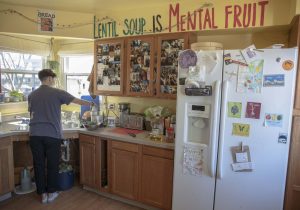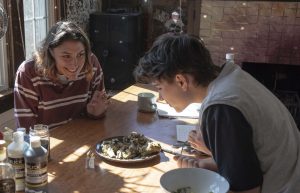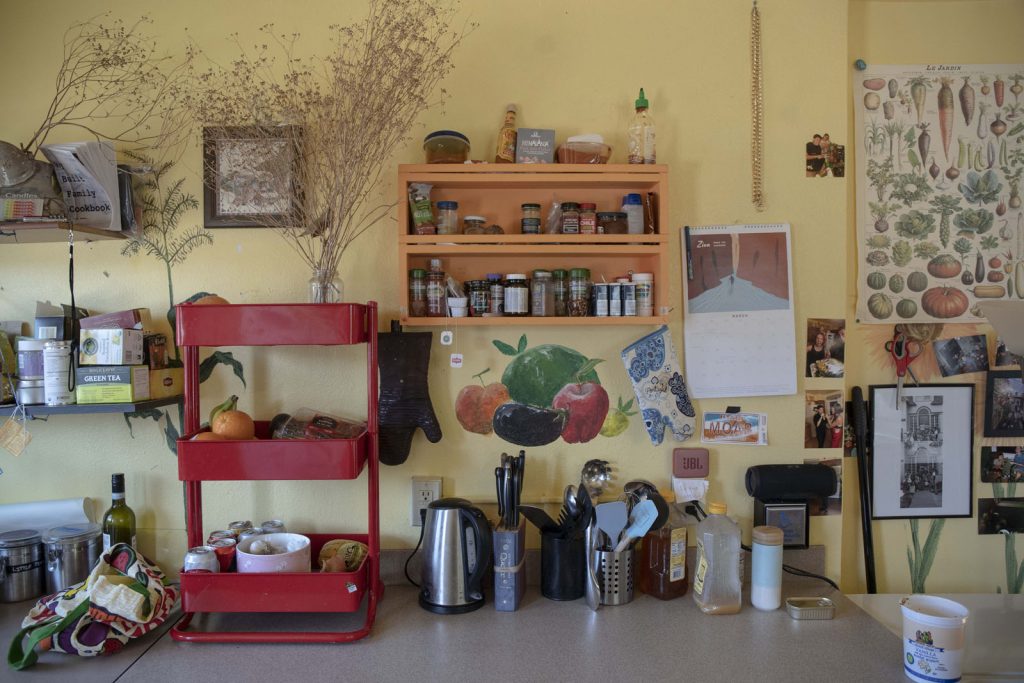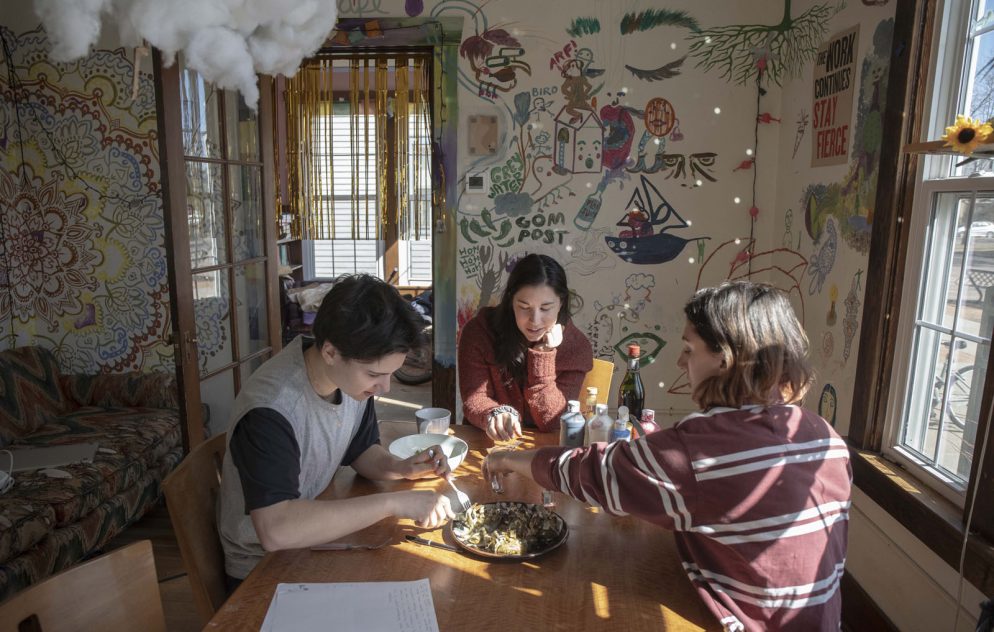First Net-Zero Energy Building Continues to Contribute to CC’s Carbon Neutrality Goals
Tucked between the sorority houses and North Weber Street on the east side of campus, two houses are visibly indistinguishable from the others around them — but what happens inside and out is unlike any other community on campus.
These buildings are home to Colorado College’s Synergy Program, a living community for students who want to work toward environmental sustainability, create a sense of community for both Synergy residents and the greater CC student body, and live independently and responsibly.

Naomi Ablao ’22 washes her dishes in New Synergy House where a compost bucket is kept below the sink and students are asked to conserve resources through food waste and reusing jars for storage as a shared value. The kitchen is decorated in photographs, something the housemates say make the space feel like it is theirs. Photo by Jennifer Coombes
About a dozen students strive to reduce their footprint while living either at “Old” Synergy House at 1018 N. Weber St., or “New” Synergy House at 1006 N. Weber St. Established in 2003, “Old” Synergy became CC’s first net-zero energy building in 2014, and has been a prototype for student life and study as the college moved toward carbon neutrality.

Liza Scher ’22 anxiously waits while her friend Lily Epstein ’22 decides to taste test her recent culinary creation, roasted artichokes with lemon aioli. The students live in the Synergy and New Synergy houses where they experience what it is like to live in a community with others who value sustainability lifestyles. Photo by Jennifer Coombes
Now that Colorado College has achieved its 2020 goal of carbon neutrality and become the eighth higher educational institution in North America to achieve such a feat, the Synergy Program is to thank for its contributions and initiatives creating sustainability awareness through its own community and the greater student body.
Synergy House residents can use an on-site greenhouse and garden, and have the freedom to transform and shape the spaces in whatever way they please. Because of their access to the greenhouse and garden, residents are not on a meal plan and rely on those resources and group meals to further create a sense of community. The garden is operated solely by Synergy members, producing vegetables to supplement their sustainable lifestyle. The houses also have their own compost piles (available for use by all CC students), where residents turn food scraps into useful mulch.
In 2014, the original Synergy House added a 7kW solar panel system. Students also utilize natural solar energy to heat the house during winter and natural ventilation to cool the house in the summer. Unique features like a heat pump water heater — which concentrates heat from the ambient air to make hot water — and a water collection system devised by the residents are other unique features of Synergy. (By recycling already used water for the garden or irrigation, there is barely any wasted water.)

After fixing herself a salad, Cameron Bacher ’22 sits at the table at New Synergy House and discusses a paper topic she has to write for her course. Those who live in the Synergy houses have planned meals where they cook or eat together so that food waste is minimal and communal living is maximized. Photo by Jennifer Coombes
But Synergy doesn’t just function as mechanically sustainable residential buildings; residents often host blockly events to create environmental awareness and a sense of community for all students, such as open mic nights or sustainably focused films open to the CC public. The events always have an environmentally responsible context, like recycled craft day or potlucks, in an attempt to bring other members of the CC student body into their home. Synergy strives, as much as possible, to be an open and accessible space, regardless of whether students are residents. Though living in the Synergy houses is a competitive and selective process, all students are welcomed and encouraged to attend events and be a part of the community.
“As a community, we have been pretty active about trying to get people into our house by advertising our events through posters in public spaces. There is an idea that you need to know somebody to live here or attend events, but in reality, we want a wide range of people to come through our space and hopefully apply to live here,” says Jasmine Linder ’22.
Amy Raymond ’21 appreciates Synergy for the independence the program offers residents, allowing for them to run their own space and decide how they want it to be operated (such as in areas of food waste and shopping habits). “The autonomy that we have at Synergy makes it a special space, as well as the experience of sharing a small space with a small group of people. In addition, the intentionality of the space makes it really special,” she says.
Linder’s favorite aspect is the bond formed among all the residents. “Learning how to live closely with people in such a tight-knit space who we may not know otherwise is really special; a kind of family tends to form here,” says Linder.
Bethany Grubbs, director of the Residential Experience, says over the years she’s seen students take great pride in the community built in the Synergy houses by crafting their own unique, sustainable experiences.

The colorful New Synergy House kitchen is kept organized and clean for group and individual meals and food storage. Photo by Jennifer Coombes
Synergy, she says, “is one of the only communities on campus that chooses their own students during the theme housing selection process. They read, interview, re-read, and re-interview about 100 students a year for roughly 10 spots.”
The students spend nearly two weeks each year going through the interview process, perpetuating the students’ value in those who live in the community. Synergy members highly value diversity in the houses, as well as applicants’ willingness to invest time and energy in living as sustainably as they possibly can.
On the outside, the houses appear to be close communities with tight group values, but Synergy’s importance radiates further than to merely those who live there. The residents are extremely proud of the values perpetuated in the community, as well as all they’ve accomplished.
“Synergy is a special housing option,” Grubbs says, “because its mission statement extends to environmental justice and activism work, attracting a community of caring, ambitious, and socially engaged people who are excited to make lasting change on campus and beyond.”









